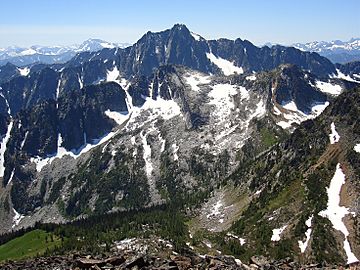Castle Peak (Washington) facts for kids
Quick facts for kids Castle Peak |
|
|---|---|

Castle Peak seen from Frosty Mountain
|
|
| Highest point | |
| Elevation | 8,306 ft (2,532 m) |
| Prominence | 3,226 ft (983 m) |
| Parent peak | Jack Mountain |
| Listing | Washington highest major summits 40th |
| Geography | |
| Location |
|
| Parent range | Hozameen Range North Cascades Cascade Range |
| Topo map | USGS Castle Peak |
| Type of rock | Granite |
| Climbing | |
| First ascent | 1904 USGS Survey party |
| Easiest route | Scrambling |
Castle Peak is a tall mountain, standing 8,306 feet (2,532 meters) high. It is located in the Hozameen Range, which is part of the North Cascades. This mountain sits right on the border between Okanogan County and Whatcom County in Washington state.
Castle Peak is only about 1 mile (1.6 km) south of the border with Canada. It is found within the beautiful Pasayten Wilderness, on land managed by the Okanogan National Forest. The closest higher mountain is Jack Mountain, which is about 14.8 miles (23.8 km) to the south-southwest. Castle Peak is the second highest peak in the Hozameen Range, after Jack Mountain. It is also one of the five most 'prominent' mountains in the Pasayten Wilderness. This means it stands out a lot from its surroundings. Rain and snow melting from the mountain flow into different rivers. Some water goes east into Castle Creek, which feeds the Similkameen River. Other water flows west into streams that join the Skagit River.
How Castle Peak Was Formed
The North Cascades area, where Castle Peak is located, has very rugged land. You can see sharp peaks, tall granite spires, and deep valleys carved by glaciers. These amazing shapes and big changes in height happened over millions of years. They also cause different weather in various parts of the mountains.
The Cascade Mountains started forming millions of years ago. This was during a time called the late Eocene Epoch. The North American Plate (a huge piece of Earth's crust) was slowly moving over the Pacific Plate. This movement caused many volcanic eruptions. Also, small pieces of Earth's crust, called terranes, came together. This helped create the North Cascades about 50 million years ago.
Later, during the Pleistocene period, which was over two million years ago, huge sheets of ice called glaciers moved across the land. These glaciers advanced and then melted back many times. As they moved, they scraped away the land, leaving behind piles of rock. The valleys in the area now have a "U" shape. This shape was created by these ancient glaciers. The land also lifted up and broke along fault lines. These processes, along with glaciation, created the tall peaks and deep valleys we see in the North Cascades today.
Mountain Weather
Most weather fronts, which bring changes in weather, start over the Pacific Ocean. They then travel northeast towards the Cascade Mountains. As these weather fronts reach the North Cascades, the tall peaks force the air to rise. When the air rises, it cools down and drops its moisture. This moisture falls as rain or snow onto the Cascades. This process is called Orographic lift.
Because of this, the western side of the North Cascades gets much more rain and snow than the eastern side. This is especially true during the winter months. In winter, the weather is often cloudy. However, during the summer, high-pressure systems form over the Pacific Ocean. These systems often bring clear skies and little to no cloud cover to the mountains.
Climbing the Peak
People enjoy climbing Castle Peak. Here are some of the known climbing routes:



